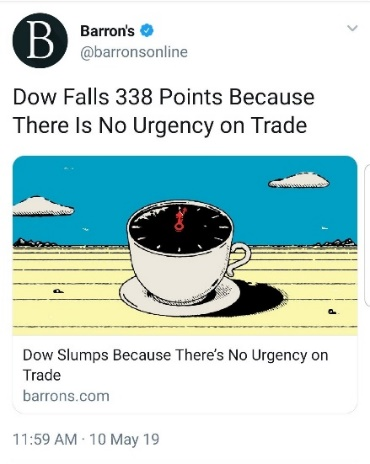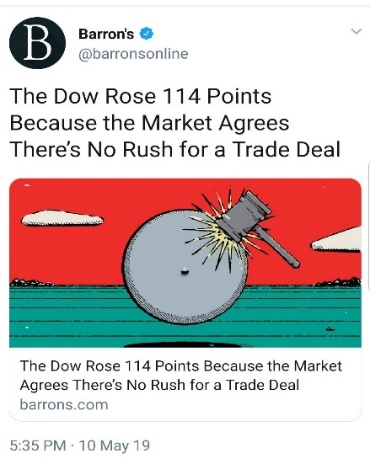The Fed Put
- Ken - Chief Rubbernecker

- May 10, 2019
- 5 min read
Updated: Apr 7, 2020
“Pictures could not be accessories to the story -- evidence -- they had to contain the story within the frame; the best picture contained a whole war within one frame.”
― Tatjana Soli, The Lotus Eaters
Enough of China and the trade deal! For months now, the financial press has been attributing the steady climb in the stock market to constant progress being made on a U.S./China trade deal. It’s been the same recycled story almost every…single…day. This past week, after months of hope and promise, we found out that this perpetually-promised, ever-impending, greatest-deal-in-the-history-of-deal-making still might not get done despite the threat of additional tariffs being levied on Chinese imports. The lunacy of forcing a narrative and attributing every wiggle in the market for months on end to the China trade talks was on full display this past Friday when these new tariffs were put in place. The market sold off in the morning before rallying to close the day up. Barron’s, one of our country’s leading and most-respected financial publications, issued the following two tweets that day:
Well, ok. A lack of urgency was both bearish and bullish on the same day! This is a nice reminder to always read financial news and opinions (yes, even mine) with a healthy dose of skepticism. There’s been plenty of speculation about the China trade talks for quite a while, but it’s not the main reason the market has been climbing this year. A deal will eventually get done, or it won’t. Neither country will accept any dramatic change that would cause significant harm, so it’s unlikely that any deal will change much in the aggregate. The net effect on the economy will be very modest, though certain individuals and industries will clearly benefit or suffer in each country. As for the increased tariffs which will remain if no deal is ultimately signed, Trump can boast of the extra income this provides the U.S., but much of these costs are passed along to the U.S. consumer. Furthermore, the conclusion of any deal (or no deal) is likely to be bearish for the markets since we won’t be able to rally on trade talk hopes anymore, and investor attention may be drawn back to far more concerning issues facing our weakening economy and overvalued markets.
In my view, there’s a much simpler and clearer explanation for this year’s stock market rebound than the China trade deal. A sharp drop in the last few months of 2018 has been followed by a normal rebound that has been boosted further by supportive rhetoric from the Federal Reserve. As bearish as I am, I cautioned on December 23 that, “Even during the [last] bear market we saw many 10-22% moves higher occur over 2-44 days. We will absolutely experience these same types of rallies this time around. In fact, I'd be surprised if we don't get one soon. The market has become very oversold on a very short-term basis.” That rally began the next day.
Some of the biggest market rallies occur near the peak of bubbles and during bear markets. It’s very normal for sharp market declines to be followed by powerful rallies. What we’ve seen this year looks to be one of those powerful counter-rallies from short-term oversold levels. This one, however, was further goosed by a dramatic shift in Federal Reserve policy earlier this year. In the span of about one month, Fed Chairman Powell went from predicting further interest rate increases and claiming that Quantitative Tightening (QT) was on autopilot to pausing interest rate increases and suggesting that QT might end sooner than originally planned (subsequently enacted). The decline in the market last year clearly spooked the Fed into action with investors once again being rewarded for their Pavlovian response of buying the dip…for now.
The notion of a Fed Put is a powerful one that has been popularized over the past 20 years. The “Put” refers to a put option strategy that provides protection if prices fall. The concept of the Fed Put is quite simple – the Federal Reserve won’t allow the markets to fall too much, so investors are protected from big price declines. The belief is that the Fed is wise, prescient, and can shift the levers of the economy and markets at will to elicit any desired outcome. Believers disregard the horrible track record of past Fed interventions and ignore the complexity and size of the economy and financial markets in order to espouse such nonsense. Still, perception matters more in the short to intermediate-term, and the widespread perception that the Fed Put is real serves to embolden risk taking. If investors think the Fed has eliminated adverse outcomes, then the best course of action is to maximize risk and buy every dip. The Fed’s about-face earlier this year and the resulting market rebound only strengthened belief in the Fed Put.

The reality is that the Fed Put is a myth. Today’s focus chart (above) shows how actively and aggressively the Fed tried to stimulate the markets and economy by lowering interest rates during the last two bear markets. Just as the Fed was quick to shift to an easing bias at the first sign of trouble this past January, it didn’t take the Fed long to start cutting interest rates at the beginning of the last two crashes. Many of those cuts were followed by large rallies, but they didn’t arrest either bear market. As for Quantitative Easing (QE), it was originally announced in November of 2008, but the bear market didn’t end for four more months. Despite popular belief, QE was not responsible for ending the bear market. The evidence shows that market forces overwhelm the Fed once investors become risk-averse during a downturn.
History has shown the Fed to be the chief enabler of asset bubbles and a consistent failure in its attempts to tweak and circumvent business and market cycles. Nevertheless, the belief persists that a handful of PhDs’ with little real-world experience are somehow able to dictate the appropriate interest rate for our complex economy and effectively control the business cycle and prevent bear markets. A superficial level of thought and a brief review of history should render this myth immediately obsolete, yet it persists. I believe we’re in an extended market-peaking process, and last fall was just a taste of what’s to come. Either way, stocks remain absurdly overvalued with few one-trick ponies left to push them significantly higher. The idea that a new bull market is about to begin from these levels beggars belief, and hope that the Fed will be able to prevent the bearish completion of this full cycle is little more than wishful thinking, just as it was during the last two bear markets and throughout history. There is no Fed Put in a bear market.
Best,
Ken Bell, CFA, CFP, MBA, Sound Money Advocate
05/10/2019
The Market Rubbernecker is associated with Aspera Financial, LLC, an investment management and financial planning firm based in the Cary, Raleigh, and Durham area of North Carolina. This and all Market Rubbernecker missives and musings (written, oral, or mimed) are subject to the disclaimers, disavowals, and hindquarter-coverings found at www.asperafinancial.com/aboutrubbernecker.









Comments